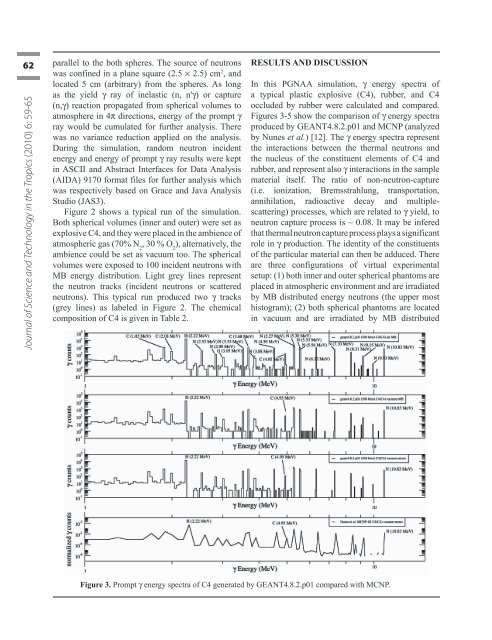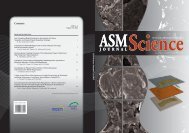Download - Akademi Sains Malaysia
Download - Akademi Sains Malaysia
Download - Akademi Sains Malaysia
Create successful ePaper yourself
Turn your PDF publications into a flip-book with our unique Google optimized e-Paper software.
62<br />
Journal of Science and Technology in the Tropics (2010) 6: 59-65<br />
parallel to the both spheres. The source of neutrons<br />
was confined in a plane square (2.5 × 2.5) cm 2 , and<br />
located 5 cm (arbitrary) from the spheres. As long<br />
as the yield γ ray of inelastic (n, n'γ) or capture<br />
(n,γ) reaction propagated from spherical volumes to<br />
atmosphere in 4π directions, energy of the prompt γ<br />
ray would be cumulated for further analysis. There<br />
was no variance reduction applied on the analysis.<br />
During the simulation, random neutron incident<br />
energy and energy of prompt γ ray results were kept<br />
in ASCII and Abstract Interfaces for Data Analysis<br />
(AIDA) 9170 format files for further analysis which<br />
was respectively based on Grace and Java Analysis<br />
Studio (JAS3).<br />
Figure 2 shows a typical run of the simulation.<br />
Both spherical volumes (inner and outer) were set as<br />
explosive C4, and they were placed in the ambience of<br />
atmospheric gas (70% N 2 , 30 % O 2 ), alternatively, the<br />
ambience could be set as vacuum too. The spherical<br />
volumes were exposed to 100 incident neutrons with<br />
MB energy distribution. Light grey lines represent<br />
the neutron tracks (incident neutrons or scattered<br />
neutrons). This typical run produced two γ tracks<br />
(grey lines) as labeled in Figure 2. The chemical<br />
composition of C4 is given in Table 2.<br />
RESULTS AND DISCUSSION<br />
In this PGNAA simulation, γ energy spectra of<br />
a typical plastic explosive (C4), rubber, and C4<br />
occluded by rubber were calculated and compared.<br />
Figures 3-5 show the comparison of γ energy spectra<br />
produced by GEANT4.8.2.p01 and MCNP (analyzed<br />
by Nunes et al.) [12]. The γ energy spectra represent<br />
the interactions between the thermal neutrons and<br />
the nucleus of the constituent elements of C4 and<br />
rubber, and represent also γ interactions in the sample<br />
material itself. The ratio of non-neutron-capture<br />
(i.e. ionization, Bremsstrahlung, transportation,<br />
annihilation, radioactive decay and multiplescattering)<br />
processes, which are related to γ yield, to<br />
neutron capture process is ~ 0.08. It may be infered<br />
that thermal neutron capture process plays a significant<br />
role in γ production. The identity of the constituents<br />
of the particular material can then be adduced. There<br />
are three configurations of virtual experimental<br />
setup: (1) both inner and outer spherical phantoms are<br />
placed in atmospheric environment and are irradiated<br />
by MB distributed energy neutrons (the upper most<br />
histogram); (2) both spherical phantoms are located<br />
in vacuum and are irradiated by MB distributed<br />
Figure 3. Prompt γ energy spectra of C4 generated by GEANT4.8.2.p01 compared with MCNP.<br />
Jostt vol 6.indd 62 7/22/10 10:10:09 PM<br />

















